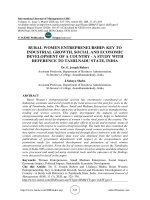Economic growth and economic development 73
Bạn đang xem bản rút gọn của tài liệu. Xem và tải ngay bản đầy đủ của tài liệu tại đây (135.72 KB, 1 trang )
Introduction to Modern Economic Growth
To do this, let us first write the steady state relationship between c∗ and s and
suppress the other parameters:
c∗ (s) = (1 − s) f (k∗ (s)) ,
= f (k∗ (s)) − δk∗ (s) ,
where the second equality exploits the fact that in steady state sf (k) = δk. Now
differentiating this second line with respect to s (again using the implicit function
theorem), we have
∂k∗
∂c∗ (s)
= [f 0 (k∗ (s)) − δ]
.
∂s
∂s
We define the golden rule saving rate sgold to be such that ∂c∗ (sgold ) /∂s = 0.
(2.21)
∗
. These
The corresponding steady-state golden rule capital stock is defined as kgold
quantities and the relationship between consumption and the saving rate are plotted
in Figure 2.6.
consumption
(1–s)f(k*gold)
0
s*gold
1
savings rate
Figure 2.6. The “golden rule” level of savings rate, which maximizes
steady-state consumption.
59









